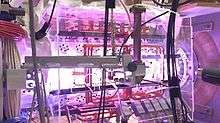Direct Fusion Drive

Direct Fusion Drive (DFD) is a conceptual low radioactivity, nuclear-fusion engine designed to produce both thrust and electric power for interplanetary spacecraft. The concept is based on the Princeton field-reversed configuration reactor invented in 2002 by Samuel A. Cohen, and is being modeled and experimentally tested at Princeton Plasma Physics Laboratory, a US Department of Energy facility, and modeled and evaluated by Princeton Satellite Systems. As of 2018, the concept has moved on to Phase II to further advance the design.
Principle
The Direct Fusion Drive (DFD) is a conceptual fusion-powered spacecraft engine, named for its ability to produce thrust from fusion without going through an intermediary electricity-generating step. The DFD uses a novel magnetic confinement and heating system, fueled with a mixture of helium-3 (He-3) and deuterium (D), to produce a high specific power, variable thrust and specific impulse, and a low-radiation spacecraft propulsion system.[1] Fusion happens when atomic nuclei, comprising one species in a hot (100 keV or 1,120,000,00 K) plasma, a collection of electrically charged particles that includes electrons and ions, join (or fuse) together, releasing enormous amounts of energy. In the DFD system, the plasma is confined in a torus-like magnetic field inside of a linear solenoidal coil and is heated by a rotating magnetic field to fusion temperatures.[1] Bremsstrahlung and synchrotron radiation emitted from the plasma are captured and converted to electricity for communications, spacecraft station-keeping, and maintaining the plasma's temperature.[2] This design uses a specially shaped radio waves (RF) "antenna" to heat the plasma.[3] The design also includes a rechargeable battery or a deuterium-oxygen auxiliary power unit to startup or restart DFD.[1]
The captured radiated energy heats to 1,500 K (1,230 °C; 2,240 °F) a He-Xe fluid that flows outside the plasma in a boron-containing structure. That energy is put through a closed-loop Brayton cycle generator to transform it into electricity for use in energizing the coils, powering the RF heater, charging the battery, communications, and station-keeping functions.[1] Adding propellant to the edge plasma flow results in a variable thrust and specific impulse when channeled and accelerated through a magnetic nozzle; this flow of momentum past the nozzle is predominantly carried by the ions as they expand through the magnetic nozzle and beyond, and thus, function as an ion thruster.[1]
Development
The construction of the experimental research device and most of its early operations were funded by the US Department of Energy. The recent studies —Phase I and Phase II— are funded by the NASA Institute for Advanced Concepts (NIAC) program.[3] A series of articles on the concept were published between 2001 and 2008; the first experimental results were reported in 2007. Numerous studies of spacecraft missions (Phase I) were published, beginning in 2012. In 2017 the team reported that "Studies of electron heating with this method have surpassed theoretical predictions, and experiments to measure ion heating in the second-generation machine are ongoing."[1] As of 2018, the concept has moved on to Phase II to further advance the design.[4][5] The full-size unit would measure approximately 2 m in diameter and 10 m long.[6]
Stephanie Thomas is vice president of Princeton Satellite Systems and also the Principal Investigator for the Direct Fusion Drive.[7]
Projected performance
Analyses predict that the Direct Fusion Drive would produce between 5-10 Newtons[1] thrust per each MW of generated fusion power,[5] with a specific impulse (Isp) of about 10,000 seconds and 200 kW available as electrical power.[4] Approximately 35% of the fusion power goes to thrust, 30% to electric power, 25% lost to heat, and 10% is recirculated for the RF heating.[1]
Modeling shows that this technology can potentially propel a spacecraft with a mass of about 1,000 kg (2,200 lb) to Pluto in 4 years.[4] Since DFD provides power as well as propulsion in one integrated device, it would also provide as much as 2 MW of power to the payloads upon arrival, expanding options for instrument selection, laser/optical communications,[1][4] and even transfer up to 50 kW of power from the orbiter to the lander through a laser beam operating at 1080 nm wavelength.[1]
The designers think that this technology can radically expand the science capability of planetary missions.[4] This dual power/propulsion technology has been suggested to be used on a Pluto orbiter and lander mission,[1][4] a well as integration on the Orion spacecraft to transport a crewed mission to Mars in a relatively short time[8][9] (4 months instead of 9 with current technology).[6]
References
- 1 2 3 4 5 6 7 8 9 10 11 Fusion-Enabled Pluto Orbiter and Lander - Phase I Final Report. (PDF) Stephanie Thomas, Princeton Satellite Systems. 2017.
- ↑ . Yosef S. Razin, Gary Pajer, Mary Breton, Eric Ham, Joseph Mueller, Michael Paluszek, Alan H. Glasser, Samuel A. Cohen. Acta Astronautica. Volume 105, Issue 1, December 2014, Pages 145-155. doi:10.1016/j.actaastro.2014.08.008.
- 1 2 Direct Fusion Drive Quad Chart. Princeton Satellite Systems. Accessed: 18 July 2018.
- 1 2 3 4 5 6 Hall, Loura (April 5, 2017). "Fusion-Enabled Pluto Orbiter and Lander". NASA. Retrieved July 14, 2018.
- 1 2 Nuclear and Future Flight Propulsion - Modeling the Thrust of the Direct Fusion Drive. Stephanie J. Thomas, Michael Paluszek, Samuel A. Cohen, Alexander Glasser. 2018 Joint Propulsion Conference, Cincinnati, Ohio. doi:10.2514/6.2018-4769
- 1 2 How Direct Fusion Drive (DFD) will Revolutionize Space Travel. Zain Husain, Brownpaceman. 1 October 2016.
- ↑ Direct Fusion Drive technical animation. Princeton Satellite Systems. Accessed 18 July 2018.
- ↑ Direct Fusion Drive to Mars – A FISO Talk. Princeton Satellite Systems. 8 August 2013. Accessed: 18 July 2018.
- ↑ Going to Mars via Fusion Power? Could Be. Michael D. Lemonick, Time. 11 September 2013.
External links
- Princeton Satellite Systems Inc Direct Fusion Drive technical animation